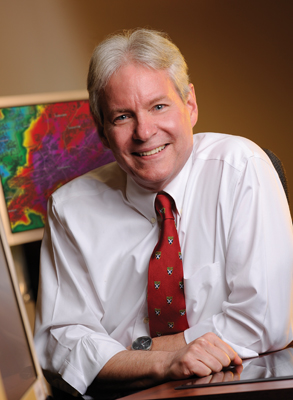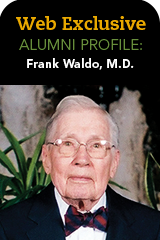A Growing Role in Disaster Response
By Rosalind Fournier |
Michael Fleenor, M.D., M.P.H., and the Jefferson County Department of Health offer public-health expertise for emergency response efforts. |
You never know when disaster will strike. But if you’re Michael Fleenor, M.D., M.P.H., the health officer for the Jefferson County Department of Health, there’s a more complicated problem: You never know what form the next disaster will take. You must prepare for all contingencies, from tornadoes to biological terrorism. This has led to an evolution in strategies for the health department in Alabama’s most populous county.
“Until the mid-1990s, we focused on more traditional public health issues, and much less on responding to disasters,” explains Fleenor, a 1979 School of Medicine graduate. “Frankly, we didn’t see ourselves as a critical part of the emergency response process.”
Then officials at the local Emergency Management Association raised concerns about a lack of disaster response coordination among government agencies. In particular, officials wanted to bring public-health experts into the planning process. “Because there’s not a natural interface among community partners and governmental agencies on a day-to-day basis, the challenge is preparing those agencies to synchronize an optimal response when disasters occur,” Fleenor says.
To build those connections, Fleenor and other local government representatives traveled to a training center in Maryland specializing in emergency preparedness. They spent 24 hours navigating a scripted disaster scenario and coordinating a response. The exercise helped identify the team’s strengths and weaknesses.
Just months later, “a category F-5 tornado blew through Jefferson County,” Fleenor recalls. “It slapped us into thinking that we had better take this more seriously, because we’re going to be called on more and more.”
They were right. In 2001, the Jefferson County Department of Health dealt with a series of suspected anthrax attacks. When emergency response experts arrived at the scenes to evaluate the potential for high-risk exposure, they were “working in a much more advanced mode,” Fleenor says. They played the same role early in 2010, when two men allegedly sent 15 letters filled with white powder to local government buildings in what proved to be a hoax.
The department’s higher profile in emergency preparedness and response creates a demand for trained experts who can cope with the aftermath of disasters, Fleenor says. As part of the civil-service system, it is difficult for the department to hire additional staff, even in times of emergency, without a lengthy approval process. In response, Fleenor has emphasized cross-training for department personnel that prepares them to change roles rapidly as needed.
“We have to be able to ‘flip a switch’ from our routine business to ‘wartime mode,’” he says. For example, following natural disasters such as tornadoes, or any event with massive power outages, his staff is prepared to inspect affected restaurants, grocery stores, and water processing stations to ensure that the public has access to a safe water supply and uncontaminated food.
Preparing natural and manmade emergencies is part of a larger shift in responsibilities that has taken the department beyond its “traditional, historic public health role,” Fleenor says. “We have retooled our efforts so that we can deliver a holistic view of community health and take on roles that plug critical gaps.”
